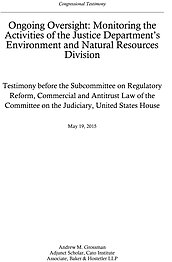While ENRD does have an agency “client” in its cases, its position as a Department of Justice component reflects Congress’s judgment that litigation over environmental law be carried out by an entity that is independent of the agencies principally responsible for policymaking and enforcement of that law and that is capable of exercising independent judgment when necessary to uphold the law and to promote broader governmental interests. In short, the idea is to avoid agency parochialism. This is not to say that the relationship between ENRD and the agencies it represents should be antagonistic, but only that the Division must be willing and able to exercise its judgment in litigation, rather than simply defer to the wishes of the agencies in every instance and pursue agency priorities at all costs. My testimony today identifies two areas of concern that merit oversight by this panel. First, in a recent decision, Judge Silberman of the United States Court of Appeals for the District of Columbia Circuit questioned whether ENRD is suffering what he called “litigation lapse[s]” to advance “the political views of its major ‘client’ (the EPA)” at the expense of broader governmental interests.2 A federal judge, of course, does not raise such questions lightly, and Judge Laurence Silberman’s statement therefore raises a serious red flag abut ENRD’s performance and priorities and whether it is deferring unduly to its agency clients.
Second is the “sue and settle” phenomenon, which raises similar concerns about the conduct and resolution of litigation that seeks to set agency regulatory priorities and (in some instances) actually influences the content of those regulations. Since the House Judiciary Committee first directed its attention to the problem of collusive settlements in 2012,3 there have been a myriad of hearings and reports focusing on this problem, as well as the introduction of legislation to constructively address it. This is heartening. But the response from some in government and from the outside groups that pursue settlements has not been to debate the merits or discuss solutions, but simply to assert that there is no problem and that litigation brought for the very purpose of setting agency priorities has no real impact. That is not so. Recent examples show that the problem is real, it is serious, and it is, if anything, getting worse. Based on precedent and the incentives faced by agencies in the waning months of a presidency, there is a real risk over the next year and a half that the current administration may attempt to employ collusive settlements and consent decrees to bind its successor. Continued oversight by this subcommittee and those with jurisdiction over the relevant agencies will be crucial in the months ahead.
The final topic of this testimony is how to alter the incentives and the legal environment that facilitate collusive settlements. Over the past three years, Members of the House and Senate have developed several bills that seek to carry out the principles identified in my 2012 testimony on abuses of settlements and consent decrees. The most comprehensive of those bills, the Sunshine for Regulatory Decrees and Settlements Act, passed the House in the previous Congress, and (as reintroduced this Congress) has drawn strong support in the Senate. Although there is little prospect that any substantial regulatory reforms will become law in this Congress, now is the time to lay the intellectual and political groundwork for an aggressive first-one-hundred-days regulatory reform agenda for the next administration.
Notes:
1 Alexis de Toqueville, Democracy in America 248 (J.P. Moyer and Max Lerner eds., Harper & Row 1996) (1832).
2Ass’n of Battery Recyclers, Inc. v. EPA, 716 F. 3d 667, 678 (D.C. Cir. 2013) (Silberman, J., concurring).


